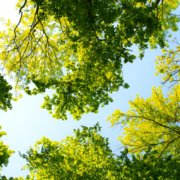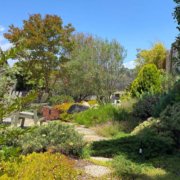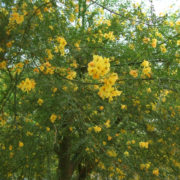Posts
Tree Care Tips Preserve Benefits During Drought
/in Conservation Corner, Features /by Gayle FalkenthalTrees are among the most valuable investment in San Diego County’s landscape – including your own waterwise landscaping. Trees stand out as key performers in your landscape design for multiple reasons. No other landscape plant offers greater benefits to your landscape and the greater environment.
Investing in tree maintenance is vital to keep them healthy. As you reassess your landscaping’s irrigation needs during extended periods of drought, allocate sufficient water to your trees, which will in turn provide multiple benefits.
Trees need time to grow and reach maturity. Saving water in the short term during a drought could result in damaged or dead trees, which could take decades to restore. According to the San Diego Regional Urban Forest Council, the cost of watering a mature tree is less than $20 each year. It can cost $1,000 to remove a dead tree. Taking care of your trees during drought ensures a tremendous return on this investment.
Multiple long-term benefits from trees
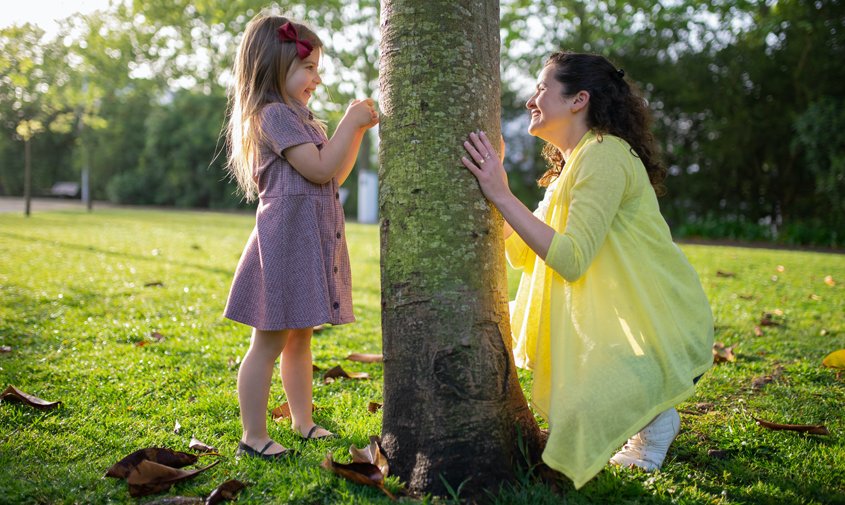
Healthy trees fight climate change and cool our cities, provide habitat, and improve the health of our neighborhoods. Photo: Kampus Production / Pexels
In the region’s dry and increasingly warming Mediterranean climate, trees help fight climate change. Trees counteract the urban heat island effect, especially in areas dominated by hardscapes such as streets, sidewalks, and building roofs. The evapotranspiration from tree leaves cools the ambient temperature down, much as perspiration lowers a person’s body temperature. Watering your trees also reduces the water needs of plants growing in their shade.
Trees provide habitat for insects, pollinators, birds, and animals – and human beings with their welcoming shade and protection. Placed properly, shade trees can reduce the use of air conditioning from 20% to 50%. The evaporation from a single tree can produce the cooling effect of ten room-size residential air conditioners operating 20 hours a day. California street trees alone save the amount of electricity it would take to air condition 530,000 households every year.
Trees protect your property, and studies show the presence of trees improves property values. Neighborhoods with more trees have lower crime rates. In business districts, trees attract customers. People linger and shop longer when trees are present. Sales rise and benefit the entire economy.
Prevent wildfire risks with healthy trees
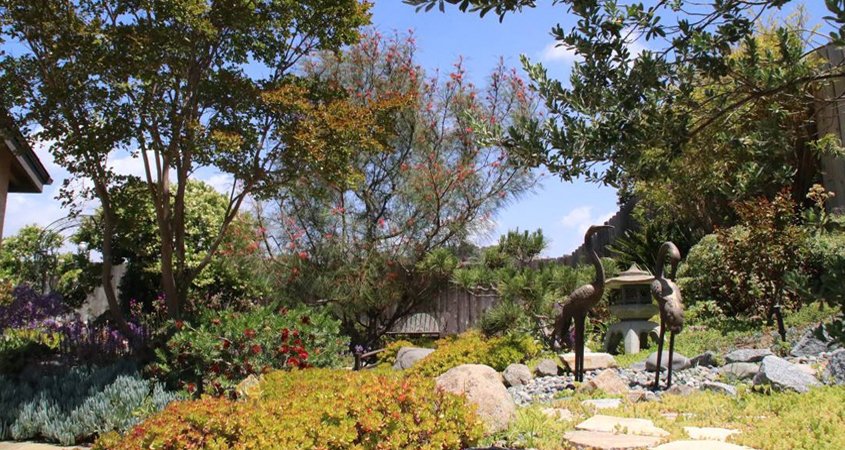
Even the strictest drought restrictions allow for watering trees on residential and commercial properties. Photo: Helix Water District
When trees die off due to drought, they become wildfire safety risks in addition to losing their many environmental and economic benefits. While any plant might die off without sufficient water, it may grow back within weeks. Drought stress can make living trees more susceptible to diseases and pests.
Even the strictest drought restrictions allow for watering trees on residential and commercial properties. The preferred method is to use a slow-release method such as a perforated bucket or low-volume non-spray irrigation.
Effective ways to water trees
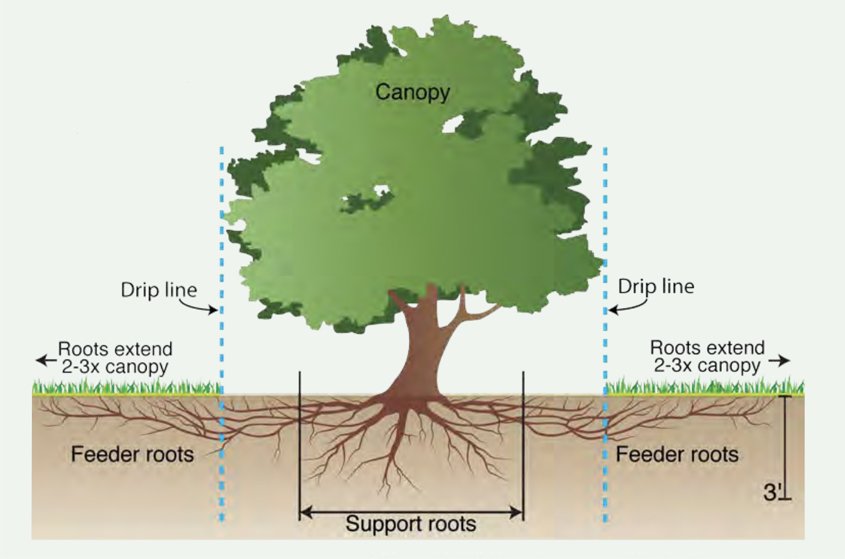
When watering your trees, water along the dripline below the canopy edge, not at the trunk. Graphic: San Diego Regional Urban Forestry Council
Trees need deep infrequent watering. Once established, once a month in the summer and during months without measurable rainfall is sufficient.
- Newly planted trees: For the first three years, water once weekly with up to five gallons of water.
- Small, established low water trees need only about 20 gallons a month. This is the same amount of water in a single average shower.
- Larger, mature low water trees need up to 200 gallons per month.
- Monitor the soil moisture under your tree and adjust amounts accordingly. You may want to use a soil probe to check at the roots.
- Apply water at the edge of the tree’s canopy, not at the trunk. This is where the roots absorb and bring water into the tree.
Trees create community. They provide inviting and cool areas for recreation and relaxation in our neighborhoods and contribute to playgrounds and parks. San Diego enjoys a perfect example right in the heart of the city. One of our greatest civic attractions is Balboa Park, full of beautiful trees planted by visionaries like Kate Sessions a century ago.
Find additional advice from the San Diego Regional Urban Forests Council on tree care and drought.
Trees: Landscaping MVP (Most Valuable Plant)
/in Conservation Corner, Features /by Gayle FalkenthalNew waterwise landscaping represents a significant investment in time and cost. Trees stand out as the most valuable players in your landscape design. No other landscape plant offers greater benefits to your landscape and the environment as a whole.
Trees save energy and clean the air. They counteract the urban heat island effect and fight climate change. Trees provide property protection and improve property values. Neighbors with more trees even have lower crime rates.
Investing in tree maintenance is vital to keep them healthy. Tree pruning should only be done for a specific reason. First, for corrective or preventative measures. Second, to remove dead, crowded, or poorly angled branches or to reduce potential hazards. Third, to increase light and air penetration for healthy growth.
Tips from pros on pruning and thinning trees
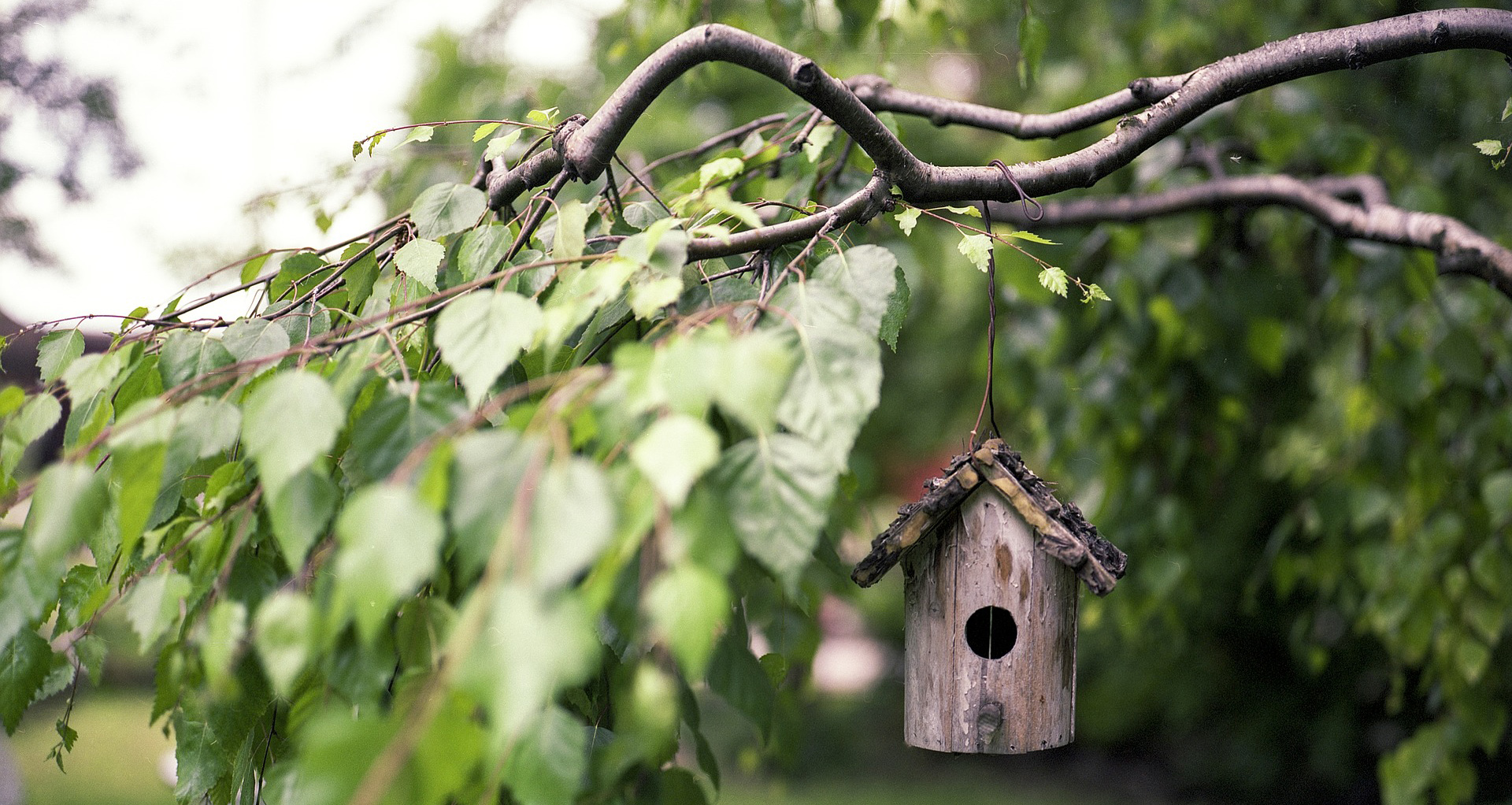
Trees are the most valuable players in your landscape design, and you can keep them healthy by using proper pruning techniques. Photo: Benjamin Balazs/Pixabay
Routine thinning does not always improve the health of a tree. Removing large amounts of foliage all at once can put stress on a tree’s stored energy reserves, resulting in stunted growth.
Pruning should be performed in the best season for the tree to avoid potential disease and to avoid pruning just after the spring growth flush.
There should be a purpose for each cut, as each cut into a tree can change the growth of the tree for many years to come. Improper or careless pruning can cause damage over the life of the tree. It is important to know where and how to make cuts before beginning the process.
When a tree branch is cut, it compartmentalizes the wound to protect itself. A small cut does less damage than a large cut. Waiting to prune a tree until it is mature can create the need for large cuts, which can threaten the life of the entire tree. Ongoing and regular maintenance is a must.
Call on a certified arborist to maintain your trees in optimal health. Arborists are specialists trained in the art and science of planting, caring for, and maintaining individual trees. They can identify and treat diseases before they spread to other trees. Find qualified professionals at the International Society of Aboriculture and the American Society of Consulting Arborists.
This article is part of a year-long series inspired by the 71-page Sustainable Landscapes Program guidebook. The Water Authority and its partners also offer other great resources for landscaping upgrades, including free WaterSmart classes at WaterSmartSD.org.
Waterwise Tree Choices for WaterSmart Landscaping
/in Home Headline, Media Coverage, San Diego County /by Kristiene Gong /Water News NetworkTrees are the single most valuable addition to your waterwise landscaping. Trees create improved water quality, resulting in less runoff and erosion. They also improve air quality and provide habitat for insects, birds, and animals. Healthy, mature trees are so beneficial, they can add an average of 10% to a property’s overall value.
When thoughtfully placed around buildings, the cooling and insulation created by a tree’s canopy can reduce air conditioning needs by 30%, and can save 20-to-50% of the energy used for heating.
Waterwise Tree Choices for Watersmart Landscaping
/in Conservation Corner, Features /by Gayle FalkenthalTrees are the single most valuable addition to your waterwise landscaping. Trees create improved water quality, resulting in less runoff and erosion. They also improve air quality and provide habitat for insects, birds, and animals. Healthy, mature trees are so beneficial, they can add an average of 10% to a property’s overall value.
When thoughtfully placed around buildings, the cooling and insulation created by a tree’s canopy can reduce air conditioning needs by 30%, and can save 20-to-50% of the energy used for heating.
Before you choose landscaping trees, research their size at maturity. When you first purchase it, it’s in a 15- or 25-gallon container and it’s hard to imagine it growing above your roofline. But a small tree can become a 30-foot tall tree with a 30-foot wide canopy of branches in a few short years. If you select a large tree species, it could be 70 feet tall and equally as wide.
Ensure tree placement gives you a sufficient distance away from your home or other structures. Small trees (30 feet wide or less at maturity) should be placed no closer than 10 feet. Large trees (70 feet wide or more at maturity) should be planted no closer than 20 feet from a house.
Top waterwise tree choices
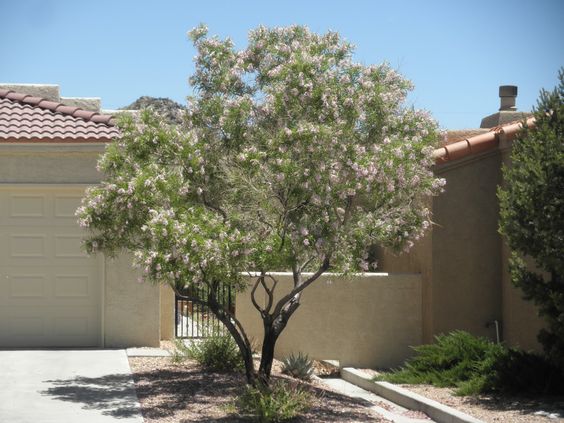
The Desert Willow is an ideal tree for its size, flowers, and waterwise nature. Photo: Pixabay
Which trees are the best waterwise choices for the San Diego region? These are five proven favorites.
Desert Willow (Chilopsis linearis)
Desert Museum Palo Verde (Parkinsonia ‘Desert Museum’)
California Redbud (Cercis occidentalis)
Catalina Ironwood (Lyonothamus floribundus)
Hybrid Strawberry Tree (Arbutus ‘Manna’)
Consider large shrubs as alternative choices
Large shrubs can be smart alternatives for screening unwanted views. Be considerate of the viewshed of your neighborhood. Will the shrubs block a special view for others?
Several best choices of waterwise small trees and shrubs for screening
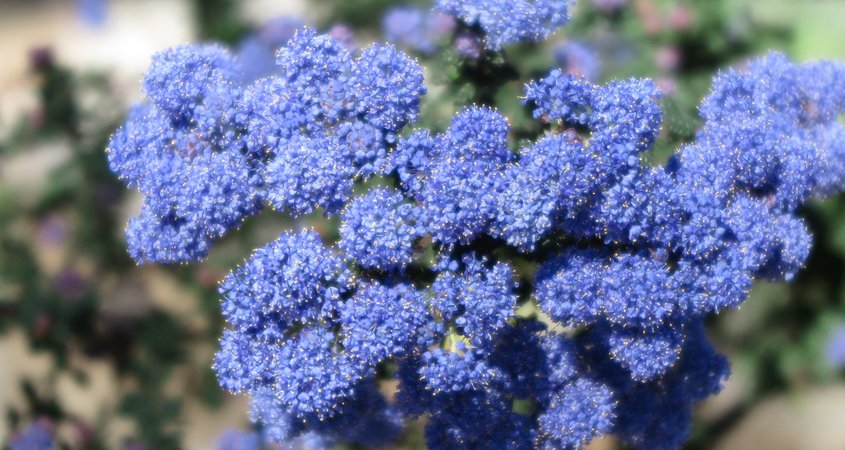
California lilac (Ceanothus) is a native plant to San Diego County and produces spectacular blooms in early spring. Photo: Wikimedia
Catalina Cherry (Prunus iliofolia ssp. Lyonii)
Pacific Was Myrtle (Myrica california)
Torrey Pine (Pinus torreyana)
Tecate Cypress (Cuppressus forbesii)
California Mountain Lilac (Ceanothus ‘Ray Hartman’)
This article is part of a year-long series inspired by the 71-page Sustainable Landscapes Program guidebook. The Water Authority and its partners also offer other great resources for landscaping upgrades, including free WaterSmart classes at WaterSmartSD.org.
Consortium Wants to Cut Down L.A. County Arboretum Trees to Make Room for Storm Water Treatment
/in Home Headline, Media Coverage, San Diego County /by Kimberlyn Velasquez /Los Angeles Timesby Louis SahagunOfficials at the Los Angeles County Arboretum and Botanic Garden are in an uproar over a plan to manage storm water and boost climate resiliency by cutting down “specimen trees” — some 70 years old and more than 100 feet tall — to make room for groundwater recharge ponds and a pump station.
Lindo Lake County Park to Get New Pier, Trees, Birdwatch Station, Better Water
/in Home Headline, Media Coverage, San Diego County /by Mike Lee /Times of San Diegoby City News ServiceSan Diego County crews began construction Friday on a $11.2 million project intended to rejuvenate and improve Lakeside’s popular Lindo Lake County Park. Improvements at the 55-acre park will include a new fishing pier and birdwatching stations, hundreds of native trees and improved water quality in the lake’s east basin by removing more than 200,000 tons of sediment — enough to cover nearly five football fields 12 feet high — which has accrued for decades.
Outcry from Environmental Groups Prompts San Diego to Retreat from Proposed Merger
/in Home Headline, Media Coverage, San Diego County /by Mike Lee /The San Diego Union-Tribuneby David GarrickOutcry from local environmental groups prompted San Diego officials Tuesday to retreat from plans to merge three longtime advisory boards that are focused on trees, marshland and green energy.
‘Ground Zero’ For Dead Trees. How California Mega-Drought Turned Creek Fire Into Inferno
/in California and the U.S., Home Headline, Media Coverage /by Chelsea Campos /The Sacramento Beeby Dale Kasler and Phillip ReeseCalifornia’s mega-drought officially ended three years ago but may have turned the Creek Fire into a monster. By killing millions of trees in the Sierra National Forest, the historic drought that ended in 2017 left an incendiary supply of dry fuel that appears to have intensified the fire that’s ravaged more than 140,000 acres in the southern Sierra Nevada, wildfire scientists and forestry experts said Tuesday.
Mission Beach Architect Raising Endangered Joshua Trees for Gardens, Landscaping
/in Home Headline, Media Coverage, San Diego County /by Mike Lee /San Diego Community News Groupby Kendra SittonIn Bob Craig’s Mission Beach house, small spiked succulents line his home, garden, and porch. During his work as an architect each day, he leaves his computer to water and check on the tiny plants that he describes as “fragile” in their first year. Looking at the diminutive plants, it is difficult to imagine that in 60 years, they will be the towering trees that make Joshua Tree National Park’s landscape stunning and otherworldly.

